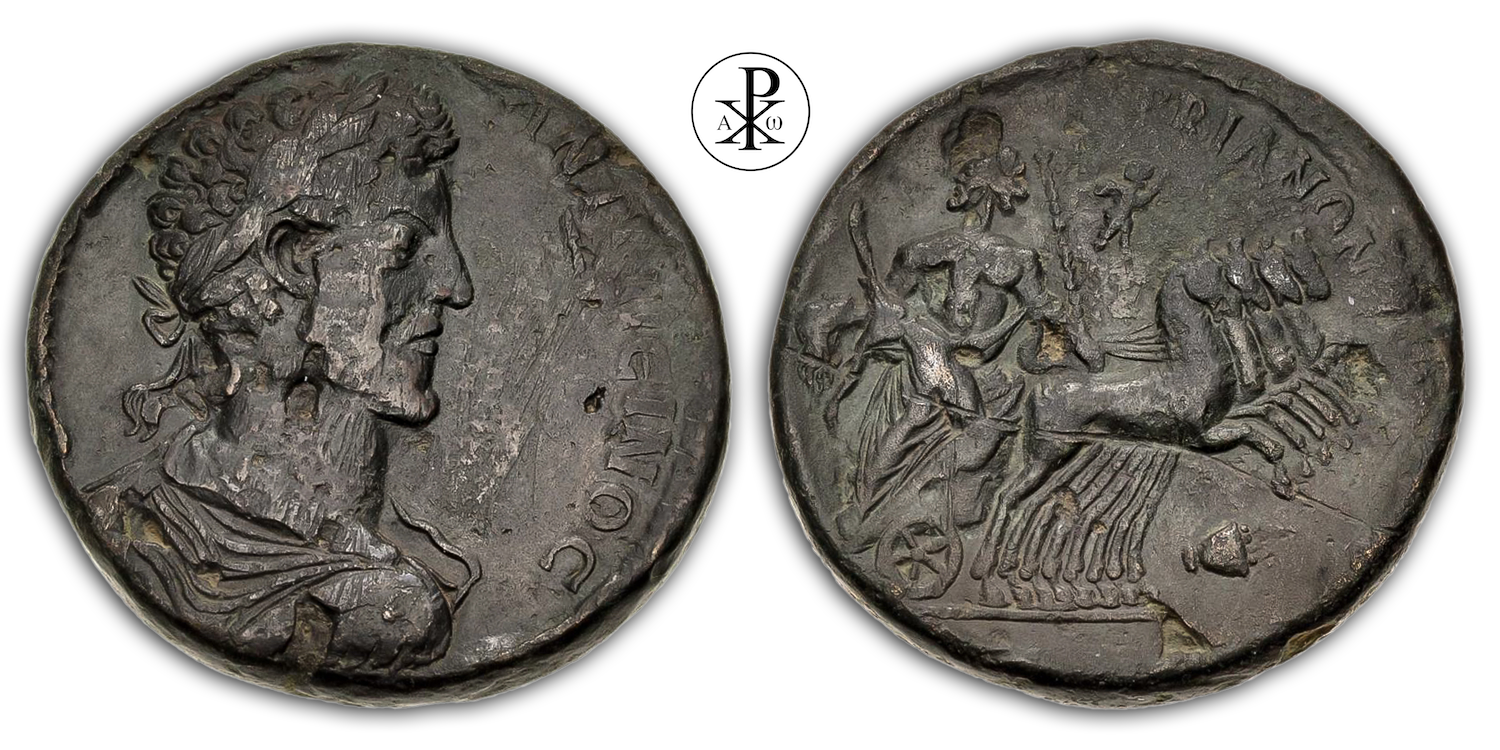Imperator Caesar Marcus Aurelius Commodus Antoninus Augustus
Reign: Commodus
Mint: Verbe (Ourbianon), Pisidia
Date: 180/191 AD
Nominal: Bronze Medallion
Material: AE
Diameter: 35mm
Weight: 34.85g
Reference: RPC IV.3 17565 (this coin)
Reference: SNG von Aulock Pisidiens I 1399 (same obverse die, but different reverse)
RPC Online: https://rpc.ashmus.ox.ac.uk/coins/4/17565
Rare: Specimens 1 (0 in the core collections)
Provenance: Leu Numismatik Winterthur, Switzerland (Auktion 14, Lot 1022)
Provenance: CNG Classical Numismatics Lancaster, USA (Auction 120, Lot 632)
Provenance: Comptoir des Monnaies Anciennes Lille, France
Pedigree: –
Special: Only known example, RPC Online Plate coin
Obverse: Laureate, draped and cuirassed bust of Commodus to right, seen from behind
Inscription: [AV KAI KOMMOΔOC] ANTΩNЄINOC
Translation: Autokrator Kaisaros Kommodos Antoneinos
Translation: Imperator Caesar Commodus Antoninus
Reverse: Hades in quadriga to right, holding scepter and carrying off Persephone; above, small Eros flying right, holding torch and guiding the horses’ reins; below, overturned kalathos containing flowers
Inscription: OYЄPBIANΩN
Translation: Ouerbianon
Translation: City of Verbe
Comment: In Greek mythology, Hades refers to the ruler of the underworld. Even before that, however, the term was used for the underworld as a place. The realm (of Hades) therefore existed before its king. In non-Christian cultic contexts, however, the word always refers to the deity, not the underworld. As king over the dead and the subterranean realms, he was early identified both with Plutos, the god of (subterranean) riches, and with the underworld god Pluton. Hades is the “Lord of the Realm of the Dead”, the stern, implacable god hated by gods and men, from whose eerie, desolate realm there is no return. He leaves his realm only very rarely, for example when he steals Persephone. Wounded in the shoulder by an arrow from Heros, he hurried to Olympus to be healed by Paian. Hades’ vehicle is a quadriga drawn by black steeds. His four black horses are called Aethon, Alastor (also called Abaster), Nykteus and Orphnaios. Pictorially represented on this bronze by Hades robbing Persephone in the quadriga and the attached Eros.
The central myth of the “Robbery of Persephone” first appears in the Homeric Hymn to Demeter. It is reported that Hades, the god of the underworld and brother of Zeus, fell in love with Kore. He therefore asked Zeus for Kore as his wife. Knowing that Kore would not voluntarily go to the sunless underworld, Zeus neither agreed nor refused. Hades interpreted this as consent. As Kore was picking flowers on the plain of Nysa, Hades rose from the underworld and carried Kore off on his team. Her cries for help were ignored by Zeus. Kore, now called Persephone, resigned herself to her fate. Meanwhile, her mother Demeter wandered about in despair and in her grief prevented all plants from growing, which forced Zeus to intervene, as there was a danger that the whole world would perish from hunger. Finally, an agreement was reached that Persephone would only spend part of the year in the underworld. Accordingly, winter occurs when Kore reigns as Persephone in the underworld and summer when Kore lives with her mother. The meaning of the myth is an allegorical representation of the cycle of the seasons. This is pictured on the coin by the overturned Kalathos with flowers – Persephone now descends with Hades and winter approaches.
In Antiquity, Verbe was a town in southwest Pisidia. It was located in the Taurus Valley, near Andeda. It has been identified with a small ancient settlement at the modern village of Yelten (formerly known as Yerten), which lies 8 km to the southeast of Pogla and 3 km to the south of Andeda. An inscription found in Andeda confirms the vicinity of Verbe. The inscription refers to a high priest, who was a citizen of Andeda but also a priest in Verbe. That topographical information is documented by Hierocles. Verbe is not mentioned by ancient sources. On inscriptions and coins dated to the Imperial period the national name Ourbianon occurs. However, the name of the ancient city cannot be restored with certainty. Nevertheless, later sources attest the names Barbe and Berbe. Information about the history of the town is scanty. Inscriptions testify the presence of a boule and a demos in the Imperial period, as well as of games. The town issued coins for the first time during Commodus’ reign and continued until the mid-3rd century. The tendency to represent certain deities on the reverse, as well as their references on inscriptions is considered an indication for their cult in Verbe. Only very few ruins are visible nowadays around Yelten, such as stone blocks, bases and reliefs.
